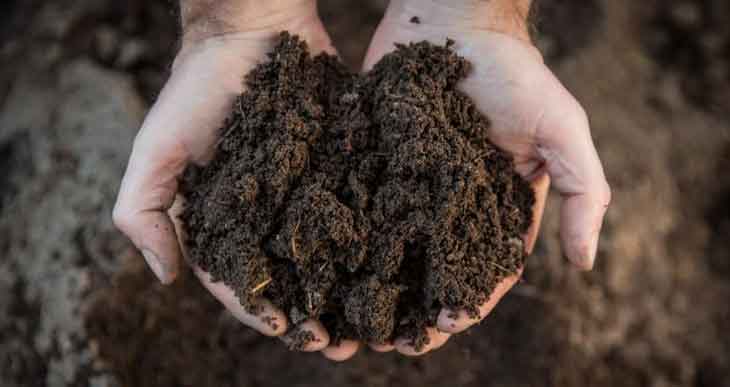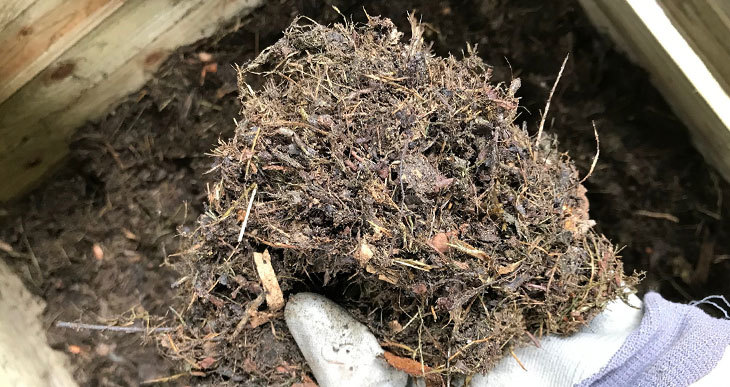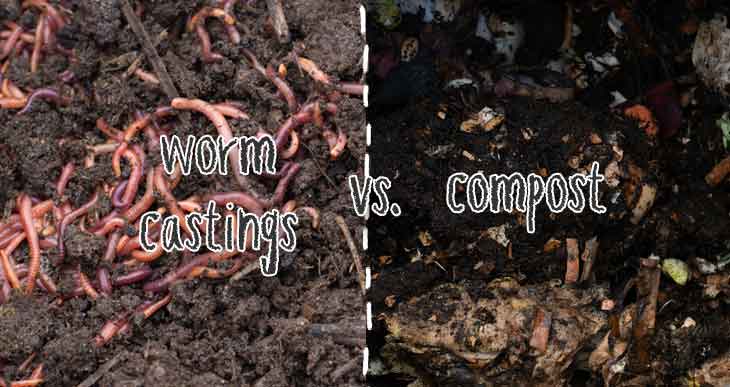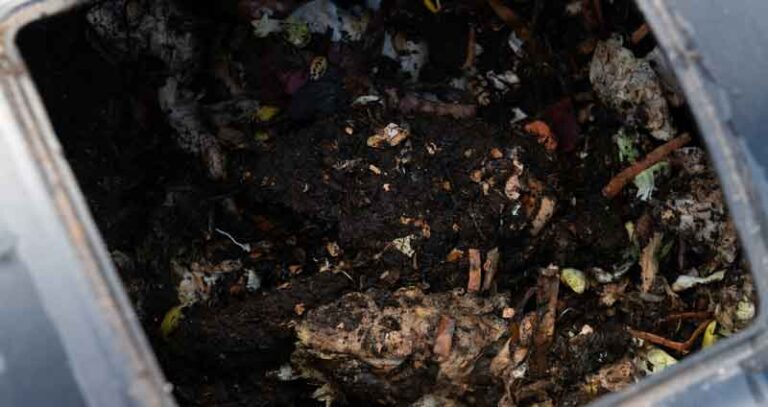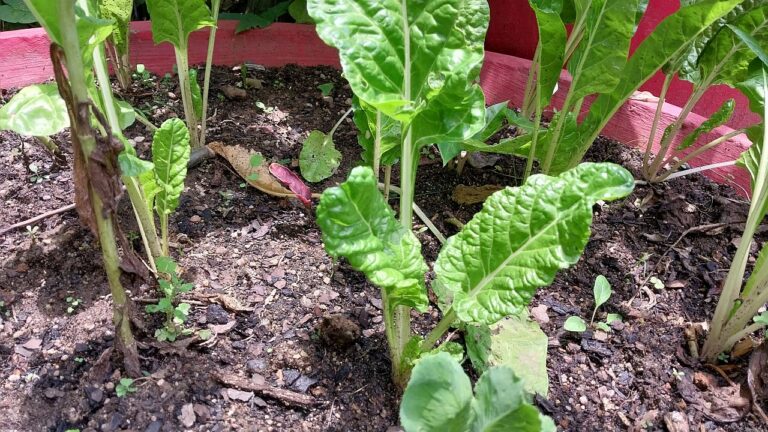Stages Of Composting (How Composting Works)

Unfortunately, you can’t just whip up some compost whenever your garden looks out of sorts.
Even in a world where you can get almost anything you want fast (pizza in 15 minutes, anyone?), you still need to wait for decent homemade compost.
There’s a good reason it takes months to make, though. To turn waste into a nutritious soil conditioner for your garden, it goes through various stages of composting.
Let’s look inside your compost heap to see what the tiny composting creatures get up to at every stage as they work to make a nutrient-packed soil supplement to help your plants thrive.
What Are The Stages Of Composting?
First, compost goes through the mesophilic stage, where decomposition speeds up and produces heat. Next is the thermophilic phase, featuring high temperatures and the further breakdown of organic wastes. Last is the curing stage, where compost cools and matures.
Each of the three composting stages comes with a different team of composting microbes, creatures, unique characteristics, and a specific purpose.
If you get clued up on these stages, you’ll know what to expect and how to keep things moving along smoothly.
Note: I’ll share essential tips for keeping your composting creatures happy, healthy, and working hard from start to finish!
The 3 Stages Of Composting
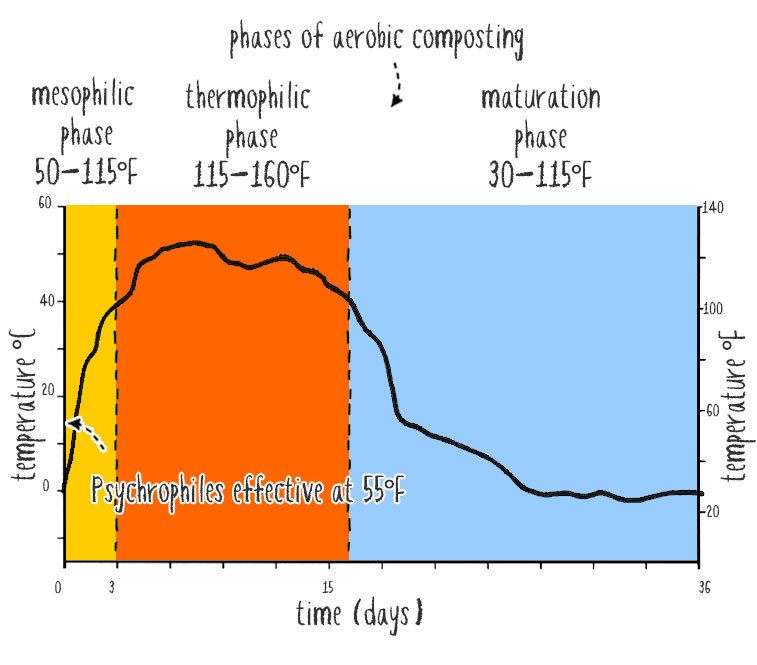
Rotting organic matter in a compost heap goes through three distinct phases of decomposition:
- Mesophilic
- Thermophilic
- Curing stages
The first phase typically only lasts a short amount of time. Then, the more active “hot” thermophilic phase is usually over in a couple of weeks. And the final stage is the longest, as activity cools down and the composting materials reach maturity.
It should be noted that these stages refer to “aerobic” decomposition (with oxygen), which is the preferred and more efficient method of making compost.
Note: the mesophilic and thermophilic bacteria get most of the spotlight because they are usually the most active organisms in a compost pile. But you should know there is a third category of bacteria called “psychrophiles.” These microbes are only active at cool temperatures of around 55°F / 12°C. So they’re soon replaced by other bacteria as fresh waste materials begin to rot. But they also allow compost piles to keep on decomposing, even in cool climates – although the decomposition rate is very slow.
Role Of Microorganisms In Composting
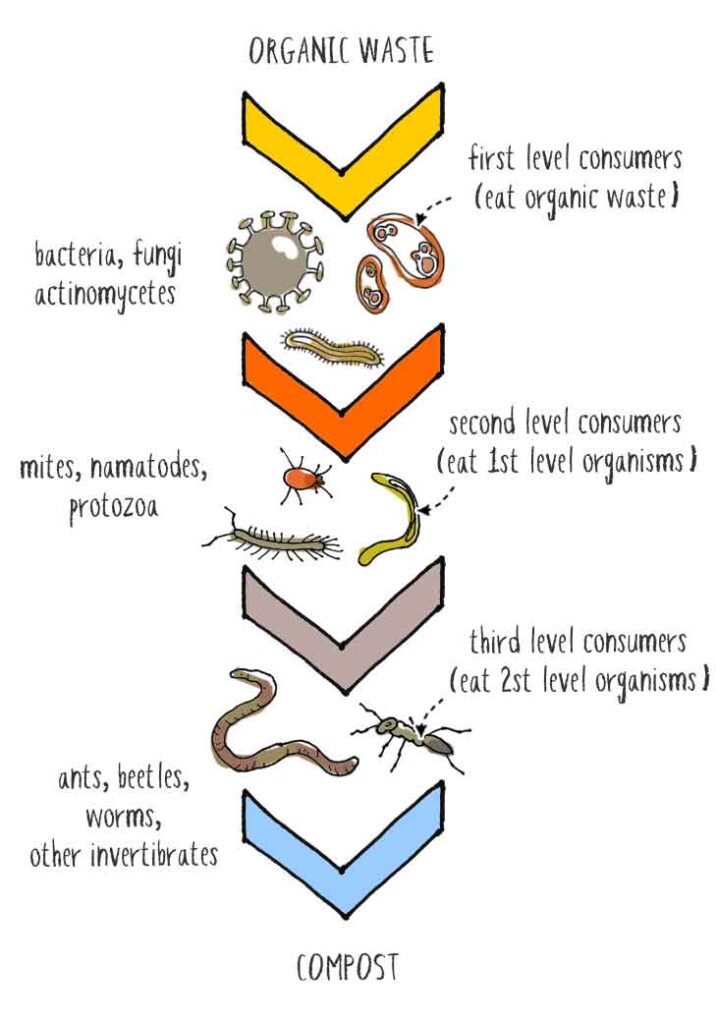
Microorganisms make composting happen.
Organic materials don’t magically break down on their own. Tiny composting bacteria and fungi work day and night to turn your kitchen and garden wastes into food for your plants. Bigger creatures like worms, centipedes, and pillbugs help out.
It’s the bacteria that do most of the composting. Of course, you can’t see them (bacteria are the smallest living creatures), but wow, they’re working hard!
And there are millions of them in a compost pile!
These little guys release enzymes that chemically break down organic wastes.
There are all sorts of bacteria in your compost. And lots of them – between 80 and 90% of the microorganisms in your heap are bacteria.
Fungi, protozoa, and rotifers make up 10 to 20% of compost life leftover. The fungi help decompose the tricky bits (like woody stems and branches) that the bacteria struggle to break down.
Protozoa and rotifers are tiny organisms found in compost’s water droplets. These tiny creatures help move the composting process along, but they leave the actual work for the other microbes.
At each composting stage, different microorganisms take over the central decomposing role.
Role of earthworms and insects in composting
A network of larger organisms such as earthworms and other invertebrates contribute an essential role in composting. They only exist in a heap during the cooler phases since they don’t like the warmth.
They feed off the microbes and their by-products and the rotting organic compost materials. And they play an instrumental role at the end of the process by helping to break down the compost into even smaller particles.
The first level of insects feeds off the compost. Then the second level of invertebrates are predators who feed on the primary insects!
Their “poop” is also rich in beneficial microbes and plant nutrients.
Actinomycetes In Compost
Actinomycetes look like grayish threads that branch out through compost, kind of like spiderwebs. They make composting bacteria’s job easier by helping to decompose things like bark and woody stems. They can also break down paper products.
Actinomycetes and fungi share a similar role (and look alike, too). But actinomycetes are actually a type of bacterium.
You’ve got actinomycetes to thank for the wonderful earthy smell of finished compost!
Tip: Actinomycetes tend to thrive in a well-aerated environment, so turn your heap on the reg to keep these little fellows active.
What Is The Mesophilic Stage Of Composting?
This is the first significant composting stage. This phase occurs when fresh waste materials are added to compost. In a well-tended compost heap, the mesophilic stage lasts about three days.
During this phase, mesophilic bacteria and fungi (and hungry insect helpers) break down the all-you-can-eat buffet of organic wastes in your compost heap. As they work, they create heat, and the compost gets hotter and hotter.
Mesophilic microorganisms do best at temperatures of about 68 to 113°F.
Unfortunately, though, pretty soon, the heat rises above these temperatures.
At this point, the mesophilic microorganisms decide it’s getting a little too hot for their liking. They then hand the leading decomposing role over to a different type of microorganism for the second composting stage.
Tip: Many gardeners complain about compost not heat and reaching the next phase of decomposition. Build your compost heap properly to kickstart the decomposition. Balance your greens (wet organic wastes like kitchen scraps) and browns (fall leaves and other dry organic wastes). Next, shovel in some topsoil (with beneficial microorganisms and maybe even a few worms!). Then add water to make the compost as damp as a wrung-out sponge and turn the pile every week.
The Thermophilic Stage Of Composting
Heat-loving thermophilic bacteria and fungi are the stars during the second composting phase, the thermophilic stage. Fungi tend to stick to the cooler outer parts of the pile when temperatures increase.
Now, the thermophilic microorganisms continue where the mesophilic microorganisms left off. They break down the organic materials into smaller bits. And they burn tons of energy, heating up the pile even more and using lots of oxygen.
Thermophilic microorganisms thrive in temperatures from 122 to 135°F. These very hot conditions help the microorganisms decompose the fats, proteins, and complex carbohydrates in our kitchen scraps and garden wastes. High temperatures are also crucial for destroying disease-causing bacteria and weed seeds in the compost.
Although thermophilic microorganisms like it hot, they can die if it gets too hot (above 149°F).
As the fats, proteins, and complex carbs start to run out, the thermophilic microorganisms have less and less to do, and the temperature in the compost heap gets cooler. This is when the mesophilic organisms step in to finish the job they started.
The thermophilic phase lasts about 12 to 14 days in a properly maintained compost pile.
Tip: Regularly turn your heap to add oxygen and keep the temperature just right. Monitor the moisture levels using a moisture meter like this one – aim for a level between 40-60%. Without help from you, the compost can get too hot and oxygen-starved. (Amazon link)
Thermophilic Bacteria For Composting
Thermophilic bacteria exist everywhere in nature and start working when the conditions are spot-on (like in compost heaps with temperatures from 122 to 135°F).
They’re a hardy bunch. These bacteria can survive extreme conditions like heat, dryness, or lack of food by forming protective spores called endospores.
This level of activity is what most gardeners call “hot composting.” It is considered the most effective state in an aerobic compost heap.
Many people consider “hot compost” the “holy grail” of composting, although some biologists believe that mesophiles are just as effective!
What Is The Curing Stage Of Composting?
During this final stage, the temperatures are cool enough for the mesophilic organisms to continue breaking down what’s left of the organic matter. Together with actinomycetes, fungi, worms, centipedes, and pillbugs, the mesophilic microorganisms make the finishing touches to your compost.
This is the final stage, resulting in what you’ve been waiting for: glorious compost!
You’ll end up with dark-brown, earthy-smelling, nutrient-rich humus compost to feed your garden when the composting team is done!
Tip: This is a low-maintenance stage. But don’t completely forget about your compost! You can take it easy with turning – a turn or two every month should be fine. The most important thing to watch at this stage is that your heap doesn’t get too wet. If it does, add quick-acting absorbent browns like clean sawdust, straw, and shredded dried leaves to the pile and mix the compost well.
Which Phase Of Composting Lasts The Longest?
The curing phase lasts the longest. If nothing goes wrong, the initial mesophilic stage generally lasts a few days, the second thermophilic stage lasts from a couple of weeks to several months, and the final curing stage lasts several months.
A Comparison Of The Three Composting Stages
Here’s a glance at the different composting stages’ characteristics:
Note: If viewing on phone, please swipe the table to scroll horizontally.
Composting Stage | First: mesophilic | Second: thermophilic | Last: curing |
Duration | A few days | A few weeks to several months | Several months |
Temperature | Moderate | High | Cool |
Organisms | Mesophilic bacteria, fungi, worms, centipedes, and pillbugs | Thermophilic bacteria, fungi, and actinomycetes | Mesophilic bacteria, fungi, actinomycetes, worms, centipedes, and pillbugs |
Results | Composting creatures start breaking down organic wastes, creating heat. | Heat-loving composting creatures break down the fats, proteins, and complex carbohydrates in organic wastes. | The composting creatures break down the remaining organic wastes, producing sweet-smelling, dark-brown, nutrient-rich compost. |
Conclusion: How Composting Works
All in all, there are three distinct stages of composting: mesophilic, thermophilic, and curing. Each step is characterized by different temperatures, durations, and types of organisms involved. However, the end result is the same: nutrient-rich compost to feed your garden!
Happy composting!


